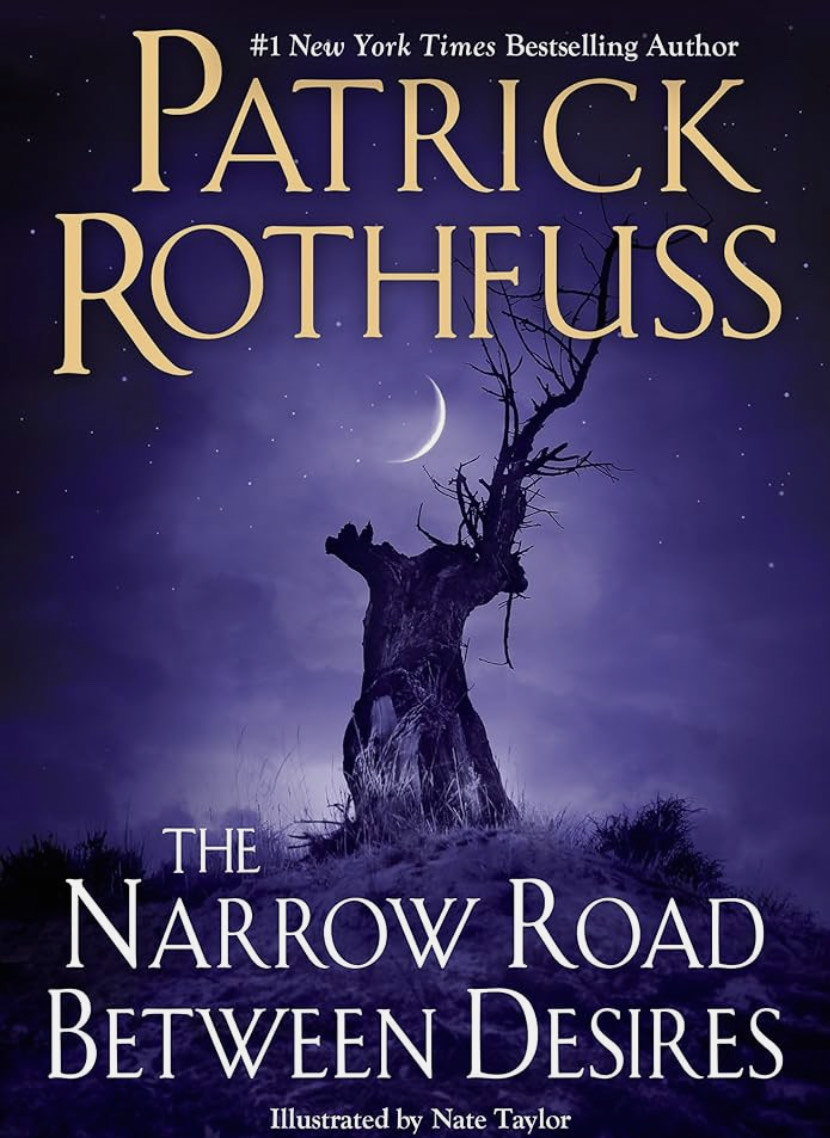‘The Narrow Road Between Desires’: Beautifully poetic, disappointingly familiar

The cover of “The Narrow Road Between Desires” is pictured. Written by Patrick Rothfuss, the novel was released on Nov. 14. (Courtesy of Astra Publishing House)
"The Narrow Road Between Desires"
Patrick Rothfuss
Nov. 14
By Gavin Meichelbock
Nov. 21, 2023 12:03 p.m.
Fans have been eagerly awaiting a new installment in the “Kingkiller Chronicle” series and still haven’t gotten it.
The second draft of Patrick Rothfuss’ 2014 short story, “The Lightning Tree,” has been slightly bulked up and released on Nov. 14 under the title “The Narrow Road Between Desires.” the story still follows the character of Bast on a usual day in the town of Newarre in the world of Temerant, as he interacts with the other townsfolk. Outside of the disappointment of this novella not being a new book, when taken on its own merits, it is an amazingly fun and engaging day-in-the-life because of Patrick Rothfuss’s writing.
[Related: Book review: Balancing novelty and nostalgia, ‘The Chalice of the Gods’ shines]
Rothfuss’ skill with the quill is unparalleled in the realm of modern fantasy. With his master craftsmanship at world building, the town of Newarre isn’t another bustling kingdom where all the major events happen in a world that is waiting for the main character to show up, defeat a darklord and save the world. Newarre is a farming village in the middle of nowhere, and readers can feel it. The villagers aren’t under attack from goblins – they have simple, and in the case of this novella, petty problems.
Throughout the novel, Bast is mostly just helping kids avoid getting in trouble with their parents over childish issues such as accidentally cutting themselves on knives or how to get revenge on their bully. In return for his help, Bast isn’t asking for their money, souls or firstborn sons. He instead gets paid in secrets, cool rocks, by having them bring him 50 of a certain kind of flower or two maple sticky buns. This seemingly mindless nothing of a novella should bore the reader within the first 15 pages, but it doesn’t. Because of the way Rothfuss writes, a little girl asking how to convince her dad to let her get a pet cat is as engaging as a walk through Middle-earth.
Rothfuss’ paragraphs all read like poetry with their beautifully alluring metaphors and similes, calculated rhythm and rhymes and cutting articulation and alliteration. His poetic form of writing makes every line of dialogue sing and every description dance off the page. Evidently, Rothfuss’ way with words fits the story’s main character Bast like skin.
Bast is depicted throughout the series, and especially in this book, as an artist. He moves with the subtle grace of a dancer and the perfect nonchalance of a cat, where every thought is calculated and every word is deliberate. When he talks, he often goes into elongated depictions and explanations where the ends of sentences start to rhyme, creating a meter of their own that carries your eyes down the page as if in a waltz with the words themselves.
Bast is also the only one in the book who talks like this – everyone else isn’t their own little Shakespeare. The other villagers talk very plainly, use slang, incorrect grammar and wear their emotions on their sleeves, unlike Bast. His perfect speech pattern separates him from the rest of the townsfolk. This otherness provides subtle clues that he is more than meets the eye, which is the main problem with this book.
Readers of the “Kingkiller Chronicle” know Bast is a Fae, a magical being from a parallel realm, so Rothruss acting as if the audience doesn’t know this fact is still a very odd choice. There is so much tongue-in-cheek about it that it will give the reader a canker sore. It works when Bast is cleverly dancing in and out of his words during conversation that provides illusions to his secret, but when it is just his inner monologue, there is no reason to be so coy. Because of this, readers don’t learn anything new about the character.
Bast is such an intriguing character in the main storyline because of his having an ulterior motive for his relationship with the series protagonist, Kvothe. The last installment in Kvothe’s story, “The Wise Man’s Fear,” even ends on a cliffhanger revolving around this motive. There are so many interesting fan theories about how Kvothe is Bast’s father or how Bast is actually the man who killed Kvothe’s parents in disguise. “The Narrow Road Between Desires” could have been a much more interesting and rewarding book if it had explored Bast’s relationship with Kvothe and answered some questions that have been left unanswered since 2007. Instead, this book is just Bast sauntering around for 208 pages seducing older women and teaching kids to lie.
[Related: Book review: V.E. Schwab weaves magic, comfort into ‘The Fragile Threads of Power’]
While it was great being able to delve back into the world of Temerant after all these years, the novel is only an extended version of a book from almost 10 years ago that expands on nothing. Instead of spending $25 hoping for a new adventure in Temerant, fans should listen to this audio recording of Rothfuss’ “The Lightning Tree” for free on YouTube. The hope of Rothfuss publishing something new is, in itself, a narrow road between desires that has yet again let die hard fans down, leaving only the slow regard of silent things and a dead series of unanswered questions behind.
Clearly, “The Narrow Road Between Desires” is a great book that should not be recommended to anyone who hasn’t already read it.

